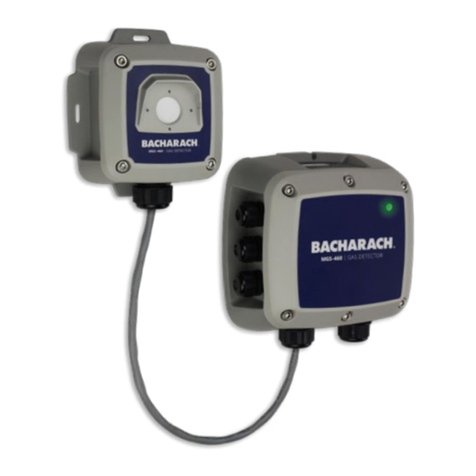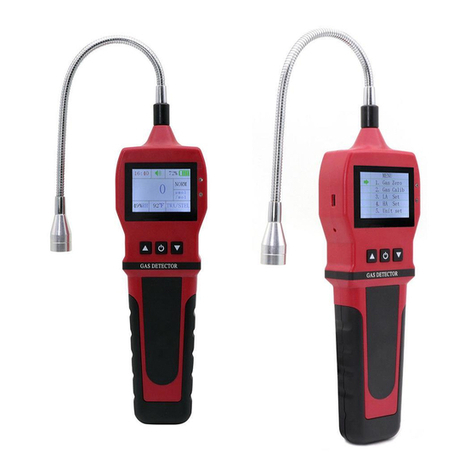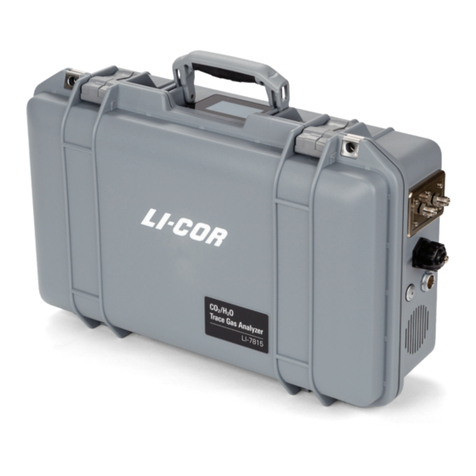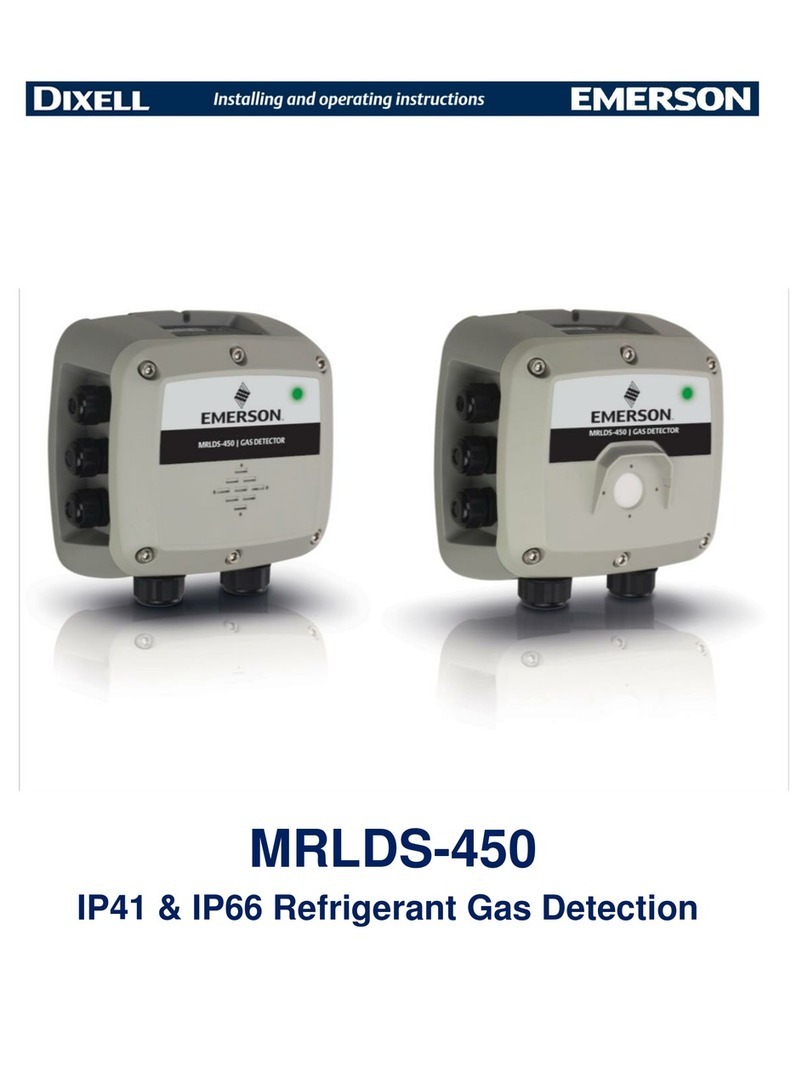Elliwell LKD 500 User manual

1
Refrigerant Leak Detection
P/N: 0024-9551 | November 2019 Revision F
Refrigerant Gas Detectors
for Machinery Rooms, Cold Rooms & Freezer
LKD 500 / 600
User
Manual

2
NOTICES
Product improvements and enhancements are on-going, therefore the specications and information contained in
this document may change without notice.
Manufacturer shall not be liable for errors contained herein or for incidental or consequential damages in connection
with the furnishing, performance, or use of this material.

3
Table of Contents
Introduction ..................................................... 5
1.1 About this Manual ........................................................................................................... 5
1.2 Conventions...................................................................................................................... 5
1.3 General Safety Statements............................................................................................. 5
1.4 Product Overview ............................................................................................................ 6
Product Description......................................... 7
2.1 Intended Uses / Applications.......................................................................................... 7
2.2 LKD 500............................................................................................................................. 8
2.2.1 LKD 500 Product Overview..........................................................................................................................8
2.2.2 LKD 500 Components ..................................................................................................................................9
2.3 LKD 600 ........................................................................................................................... 10
2.3.1 LKD 600 Product Overview........................................................................................................................10
2.3.2 LKD 600 Design Features...........................................................................................................................11
Installation ..................................................... 13
3.1 General Information...................................................................................................... 13
3.2 Restrictions..................................................................................................................... 14
3.3 Mechanical Installation................................................................................................. 14
3.4 Electrical Installation..................................................................................................... 15
3.4.1 Preparations...............................................................................................................................................15
3.4.2 Power & Signal Wiring ...............................................................................................................................15
3.4.3 Relay Wiring................................................................................................................................................16
3.4.4 Installation of Remote Sensing Head (LKD 600) .....................................................................................17
3.4.5 Modbus RTU RS-485 Interface ..................................................................................................................18
3.4.6 Conclusion ..................................................................................................................................................19
Operation........................................................ 20
4.1 Overview of Normal Operation.................................................................................... 20
4.1.1 Applying Power & the Start-up Sequence................................................................................................21
4.1.2 Verifying Analog Signals ............................................................................................................................21
4.1.3 Verifying the Modbus Signal .....................................................................................................................22
4.1.4 Status Indication ........................................................................................................................................22
4.1.5 Switch Functions.........................................................................................................................................23
4.1.6 Reset System to Factory Default Settings.................................................................................................24

4
Care & Maintenance ...................................... 25
5.1 Overview of Normal Operation.................................................................................... 25
5.2 Adjustments ................................................................................................................... 26
5.2.1 Introduction................................................................................................................................................26
5.2.2 General Calibration Procedure ................................................................................................................26
5.2.3 Zero Adjustment.........................................................................................................................................27
5.2.4 Span Adjustment........................................................................................................................................28
5.2.5 System Bump Test......................................................................................................................................29
5.3 Troubleshooting............................................................................................................. 30
5.3.1 Hexadecimal Format .................................................................................................................................30
5.3.2 Fault Codes .................................................................................................................................................30
5.4 Sensor Maintenance...................................................................................................... 33
5.4.1 Replacing the Sensor Module ...................................................................................................................33
5.5 Cleaning the Instrument............................................................................................... 33
Additional Information ................................. 34
6.1 Sensor Principle ............................................................................................................. 34
6.1.1 Electrochemical Sensors............................................................................................................................34
6.1.2 Catalytic Bead Sensors ..............................................................................................................................34
6.1.3 Semiconductor Sensors.............................................................................................................................35
6.1.4 Infrared Sensors.........................................................................................................................................36
6.2 Disposing of the Instrument......................................................................................... 36
6.2.1 Disposing of the Electrical & Electronic Equipment................................................................................36
6.2.2 Disposing of Sensors..................................................................................................................................36
6.3 TechnicalSpecications................................................................................................ 37
6.3.1 GeneralSpecications...............................................................................................................................37
6.3.2 SensorSpecications.................................................................................................................................39
6.4 Modbus Registers .......................................................................................................... 40
6.4.1 Integration - Dynamic Sensor Data..........................................................................................................40
6.4.2 Integration - Static Sensor Data ...............................................................................................................42
6.4.3 Integration - General System Setup .........................................................................................................45
6.4.4 Integration - Calibration............................................................................................................................47
6.4.5 Integration - User Debug Tools.................................................................................................................47
6.4.6 LKD Compatibility - Status Flags...............................................................................................................48
6.4.7 Integration - Status Flags ..........................................................................................................................48
6.4.8 LKD Compatibility - Clear Special States .................................................................................................49
6.4.9 Integration - User Task ..............................................................................................................................49

5
1. Introduction
1.1 About this Manual
Thank you for investing in a LKD Gas Detector. To ensure operator safety and the proper
use of the gas detector, please read the contents of this manual for important information
on the operation and maintenance of the instrument.
IMPORTANT: Before installing this product, carefully read and strictly follow the
instructions in the manual.
Alert Icon Description
DANGER Imminently hazardous situation which, if not avoided, will result
in death or serious injury.
WARNING Potentially hazardous situation which, if not avoided, could
result in death or serious injury.
WARNING Potential electrical shock hazard which, if not avoided, could
result in death or serious injury.
CAUTION
Potentially hazardous situation which, if not avoided, could result
in physical injury or damage to the product or environment. It
may also be used to alert against unsafe practices.
IMPORTANT Additional information on how to use the product.
1.2 Iconography
1.3 General Safety Statements
IMPORTANT: Before using this product, carefully read and strictly follow the instructions
in the manual. Ensure that all product documentation is retained and available to
anyone operating the instrument.

6
1.4 Product Overview
WARNING: Before connecting this instrument to electrical devices not mentioned in
this manual, consult the manufacturer or a qualied professional. Failure to comply
may result in injury and / or damage to the product.
DANGER: This instrument is neither certied nor approved for operation in oxygen-
enriched atmospheres. Failure to comply may result in personal injury or death.
WARNING: Use this product only for the purposes specied in this document and
under the conditions listed.
WARNING: This instrument has not been designed to be intrinsically safe for use
in areas classied as being hazardous locations. For your safety, DO NOT use it in
hazardous (classied) locations.
WARNING: In the event of an alarm or over-range condition, the sensor must be
recalibrated to ensure continued accuracy.
WARNING: This product must be recalibrated if installed in a non-room condition
environment (i.e. temperature or humidity extremes).
WARNING: The gas diusion path can become occluded (moisture, dust, debris, frozen
condensation) over time resulting in reduced or complete lack of gas detection and
alarming function. Routine visual inspection of the gas detector and bump testing are
suggested to ensure proper gas detection and alarm function.
CAUTION: Except for maintenance detailed in this manual, these products should only
be opened and / or serviced by authorized Bacharach personnel. Failure to comply may
void the warrant.
CAUTION: Operator assumes responsibility for complying with all laws, rules and
regulations governing the use of this product.
CAUTION: Use only genuine Bacharach parts and accessories. Failure to comply may
impair the operation of the product and / or void the warranty.
CAUTION: Only operate the product within the framework of a risk-based alarm
signaling concept.

7
2. Product Description
2.1 Intended Uses / Applications
LKD Gas Detection Series instruments continuously monitor ambient air (indoor or outdoor)
for the following gas types:
• Refrigerants
• Toxic and combustible gases
The instruments may be purchased in the following congurations:
• LKD 500 - IP66
• LKD 500 - IP41
• LKD 600 - IP66 with Remote IP66 Sensor
LKD gas detectors may be connected to a third-party device capable of accepting digital and/
or analog outputs from the gas detectors, such as a Building Management System (BMS),
Programmable Logic Controller (PLC) and/or Modbus RTU. With the integrated audio-visual
alarm indication, an instrument can be operated as a stand-alone unit (with additional local
alarm signaling as required).
WARNING: This instrument is neither certied nor approved for operation in oxygen-
enriched atmospheres. Failure to comply may result in EXPLOSION.
WARNING: This instrument has not been designed to be intrinsically safe for use in
areas classied as being hazardous locations. For your safety, DO NOT use it in hazardous
(classied) locations.

8
2.2 LKD 500
2.2.1 LKD 500 Product Overview
The LKD continuously monitors indoor or outdoor ambient air for the following gases:
• Refrigerants
• Toxic and combustible gases
The instruments may be purchased in one of two congurations with or without relays
output:
• LKD 500 - IP66
• LKD 500 - IP41
With the integrated Modbus communication, analog output and relays, the instrument can
be operated as a stand-alone unit or a third-party device capable of accepting digital and/
or analog outputs from the gas detectors, such as a Building Management System (BMS) ,
a Programmable Logic Controller (PLC) and/or Modbus RTU. The instrument is designed to
be installed in non-classied, non-hazardous, permanent locations.

9
2.2.2 LKD 500 Components
This product uses semiconductors which can be damaged by electrostatic discharge (ESD).
When handling the PCB, care must be taken so that the electronics are not damaged.
(MAG #2)(MAG #1)
# COMPONENT DESCRIPTION # COMPONENT DESCRIPTION
1M16 Cable Glands (×6) 8Ribbon Cable Connection (To Sensor)
2Rubber Gasket (IP66 Version Only) 9Tactile Switch #2
3Internal Alarm Buzzer 10 Relay 2 Connection (HIGH)
4Power Connections (×2) 11 Relay 1 Connection (LOW)
5Digital Connection (Modbus) 12 Magnetic Switch #1
6Analog Connection 13 Magnetic Switch #2
7Tactile Switch #1 14 M20 Cable Glands (×2)

10
2.3 LKD 600
2.3.1 LKD 600 Product Overview
The LKD 600 continuously monitors indoor or outdoor ambient air for the following gases:
• Refrigerants
• Toxic and combustible gases
The instruments may be purchased in one of two congurations with or without relays
output:
• IP66 with Remote IP66 Sensor, connected via RJ45 cable (up to 20 meters ?? in length)
With the integrated Modbus communication, analog output and relays, the instrument can
be operated as a stand-alone unit or a third-party device capable of accepting digital and/
or analog outputs from the gas detectors, such as a Building Management System (BMS),
a Programmable Logic Controller (PLC) and/or Modbus RTU. The instrument is designed to
be installed in non-classied, non-hazardous, permanent locations.

11
2.3.2 LKD 600 Design Features
Transmitter options:
2× IP66 rated ABS enclosure connected via RJ45 cable (up to 5 meters in length)
Power options:
24 VAC
19.5 to 28.5 VDC
Diagnostic/status LED (3 color: green, orange and red)
Congurable output signal options:
2 x relays as option (high alarm / low alarm / fault)
1× Analog Output (4 to 20 mA, 0 to 5 V, 0 to 10 V, 1 to 5 V, 2 to 10 V)
Digital output Modbus RTU signal
Pre-calibrated sensor exchange modules can be used for maintenance of the instrument
instead of performing gas calibration on site.
Non-intrusive magnetic wand can be used to initiate calibration of the device.

12
# COMPONENT DESCRIPTION # COMPONENT DESCRIPTION
1M16 Cable Glands (×6) 9Tactile Switch #2
2Rubber Gaskets (×2) 10 Relay 2 Connection (HIGH)
3Internal Alarm Buzzer 11 Relay 1 Connection (LOW)
4Power Connections (×2) 12 Magnetic Switch #1
5Digital Connection (Modbus) 13 Magnetic Switch #2
6Analog Connection 14 M20 Cable Glands (×2)
7Tactile Switch #1 15 Ribbon Cable Connection (To Sensor)
8Remote Sensor Connections (×2)
(MAG #2)
Connection Cable
(MAG #1)
Remote Sensor
Transmitter

13
3. Installation
3.1 General Information
Every detail of installation site selection is critical to ensure overall system performance and
eectiveness. Strict compliance and considerable thought must be given to every detail of
the installation process, including, but not limited to the following:
• Regulations as well as local, state, and national codes that govern the installation of
gas monitoring equipment
• Electrical codes that govern the routing and connection of electrical power and signal
cables to gas monitoring equipment
• The full range of environmental conditions to which the instruments will be exposed
• The physical characteristics of the gas or vapor to be detected
• Thespecicsoftheapplication(e.g.,possibleleaks,airmovement/draft,etc.)
• The degree of accessibility required for maintenance purposes
• The types of optional equipment and accessories that will be used with the system
• Anylimitingfactorsorregulationsthatwouldaectsystemperformanceorinstallations
• Wiring details, including:
– The LKD 500 enclosure provides the following cable gland openings:
2×, M20, supports 10-14mm cable outer diameter
6×, M16, supports 4-8mm cable outer diameter
– The LKD 600 enclosure provides the following cable gland openings:
1×, M20, supports 10-14mm cable outer diameter
6×, M16, supports 4-8mm cable outer diameter
IMPORTANT: The manufacturer of this product requires that a bump test or calibration
be performed following installation to verify instrument functionality.

14
– Secondary circuit must be supplied from an isolating source
– The wiring for the relays must be selected and fused according to the rated voltages,
currents, and environmental conditions
– If stranded conductors are used, a ferrule should be used
– To comply with RFI immunity regulations, it is necessary to ground the shield of
the communications cable at the PLC, GDA controller, front-end controller, or Building
Management System (e.g., the chassis, the ground bus-bar, etc.).
3.2 Restrictions
The installation location must have appropriate supply power available for the instrument
(i.e., 19.5 to 28.5 VDC or 24 VAC). This ultimately determines the distance the instrument
can be mounted from the controller or power supply.
3.3 Mechanical Installation
The installation location must have appropriate supply power available for the instrument
(i.e., 19.5 to 28.5 VDC or 24 VAC). This ultimately determines the distance the instrument
can be mounted from the controller or power supply.
WARNING: DO NOT allow the lid / sensor to hang from the ribbon cable. Failure to
comply may result in damage to the product.
Using the provided hardware, securely mount the LKD Gas Detector according to the
product dimensions, maximum wiring lengths and following considerations:
• Environment: the full range of environmental conditions when selecting a location.
• Application: the specics of the application (possible leaks,air movement / draft,
etc.) when selecting a location.
• Accessibility: the degree of accessibility required for maintenance purposes when
selecting a location.
• Target Gas: the specific gravity of the target gas when selecting the height of
the instrument.
1. Usinga5/32″(4 mm)hexkey/allenwrench(not included) remove the lid and disconnect
the ribbon cable from the base.
2. Setthelidandrubbergasket (IP66 version only) aside to be reinstalled later.

15
3.4 Electrical Installation
3.4.1 Preparations
WARNING: Ensure wiring for relays and connections for sensor(s) are made before
applying power.
CAUTION: This product uses semiconductors which can be damaged by electrostatic
discharge (ESD). When handling the printed circuit boards (PCBs), observe proper ESD
precautions so that the electronics are not damaged.
3.4.2 Power & Signal Wiring
The product comes with cable glands and plugs pre-installed. The power entry cable gland is
without a gland plug. Use the appropriate cable glands to insert and connect the wires for power
and signal to the appropriate terminals as indicated in the gure and wiring table that follow. The
PCB terminal blocks are pluggable type and may be removed to aid termination.
Polarity must not be reversed.
For 24 VAC installations in a daisy-chain conguration, the neutral polarity must be maintained for
all instruments.
Fasten terminal screws.

16
Connection Description Label Wiring Termination
Power
24 VDC/VAC IN 24V IN: - 24 VDC/VAC neutral /
ground
24V IN: + 24 VAC neutral
24 VDC/VAC OUT
(power daisy chain
terminal)
24V OUT: - 24 VDC/VAC neutral /
ground
24V OUT: + 24 VAC neutral
Digital Output Modbus Network
Communications
MODBUS: B RS-485 “B” (inverted)
MODBUS: A RS-485 “A” (non-
inverted)
MODBUS: GND RS-485 GND
MODBUS: SH RS-485 Shield
Analog Output Voltage or Current ANALOG: - Analog output ground
Output ANALOG: + Analog output signal (+)
3.4.3 Relay Wiring
WARNING: Relays are rated for 0 to 24 VAC/DC. DO NOT apply mains power onto
these relays.
Using appropriate cable glands, connect the wires for relay 1 and relay 2 to the terminals as
indicated in the following wiring table.
Relay Function
1Low Alarm
2High Alarm
When congured according to the factory default settings, the relays are de-energized during
normal operation (not fail-safe). Fail-safe mode can be congured. When congured for fail-safe
operation, relays are energized during normal operation. Fail-safe operation ensures relays are
triggered in cases of power failure at the instrument. In failsafe operation normally open and
normally closed terminals are reversed as indicated by the following table

17
Terminal Normal Operation Failsafe Operation
NC Normally Closed Normally Closed
COM Common Common
NO Normally Open Normally Closed
3.4.4InstallationofRemoteSensingHead(LKD600)
Standard RJ45 “Cat 5E STP” Ethernet cables up to 5 meters long may be used with the remote
sensor. The cable provided from the factory is 5 meters long.
IMPORTANT: Before using this product, carefully read and strictly follow the instructions
in the manual. Ensure that all product documentation is retained and available to
anyone operating the instrument.
Remove the bottom right M20 cable gland plug and gland cap, and carefully remove the gland
rubber insert. The rubber insert is split to allow it to be installed around the provided RJ45 cable.
Slip the cable gland nut over one end of the terminated RJ45 cable. Apply the split rubber insert
onto the cable so that it is between the gland nut and the end of the cable.
Feed the RJ45 connector through a cable gland and into the enclosure, taking care to not damage
the PCB.
Reassemble the cable gland by sliding the rubber insert into the gland body and then tightening
the gland nut. Conrm that the RJ45 cable is not binding or stressing the PCB terminal blocks
(leave no excess cable inside the enclosure).
Plug the RJ45 connector into the provided RJ45 socket.
IMPORTANT: Before using this product, carefully read and strictly follow the instructions
in the manual. Ensure that all product documentation is retained and available to
anyone operating the instrument.

18
3.4.5 Modbus RTU RS-485 Interface
For the Modbus RS-485 network use a 16 to 24 AWG (0.5 to 1 mm2) 3-core, 2 twisted pair + ground,
shielded cable with 120 Ω characteristic impedance.
Recommended: Belden 3106A (or equivalent)
The Modbus address, baud rate, stop bit, parity and slave termination is congured through the
setup menu. No jumpers or hardware switch settings are required.
Ensure that the communication parameters within the network, including the Building Management
System, are congured identically.
To ensure optimal performance of the Modbus network ensure the following guidelines
are implemented:
• Ensureinstrumentsareconguredinasinglebustopology,connectingmultiplebuses
in parallel or branching multiple units from the main bus, may introduce impedance
mismatches,reectionsand/orsignaldistortions
• Avoid long stubs when connecting instruments to the bus, stubs should be less than
1 meter in length
• Ensureinstrumentsatendofbushave120Ωterminatingresistorenabled.Terminating
resistorsmaybeenabled(refertoSection4.2.3.6formoreinformation).
• EnsureA/BsignalpolarityismaintainedthroughoutRS-485network
• Connect cable shield drain to physical earth or ground at the controller only.
• Connectcableshielddrainto(SH)terminalatinstrument
• EnsurecableshieldintegrityismaintainedthroughoutRS-485network.
• Do not use shield connection for signal ground. Use cable that provides dedicated ground
conductorforsignalground.Connectsignalgroundto(GND)terminalofinstrument.

19
3.4.6 Conclusion
After all wiring is completed, power the transmitter and conrm operation, and then prepare to
seal the enclosure. Note that the IP 41 congurations do not include a sealing gasket.
Ensure gasket is aligned correctly (IP66 versions only) and tighten the lid using the supplied
hardware in an “X” pattern. To achieve proper seal, the lid screws should be torqued to 15 to 20
lbf in (1.5 to 2.0 Nm).

20
4. Operation
4.1 Overview of Normal Operation
WARNING: Before leaving the instrument for normal operation, check the conguration
for proper settings and check calibration.
4.1.1 Applying Power & the Start-up Sequence
After applying power, the instrument will go through a start-up sequence (initialization, audible/
visual test and self-test sequence). After start-up sequence completes, the instrument will enter a
warm-up period to allow the sensor element to stabilize before reporting a valid output.
Step Description
1. Switch power on.
2.
Observe start-up sequence and warm-up phase.
· Green LED will blink at 0.5 Hz for about 5 minutes
· Modbus ag for warm-up is set
· Buzzer is o
· Relay state is “no alarm”
· Gas reading invalid
3.
Observe normal operation.
· Green LED is steady on
· Modbus ag for warm-up is cleared
· Buzzer is o
· Relay state is “no alarm”
· Gas reading valid
This manual suits for next models
1
Table of contents
Popular Gas Detector manuals by other brands

Seitron
Seitron BEAGLE manual
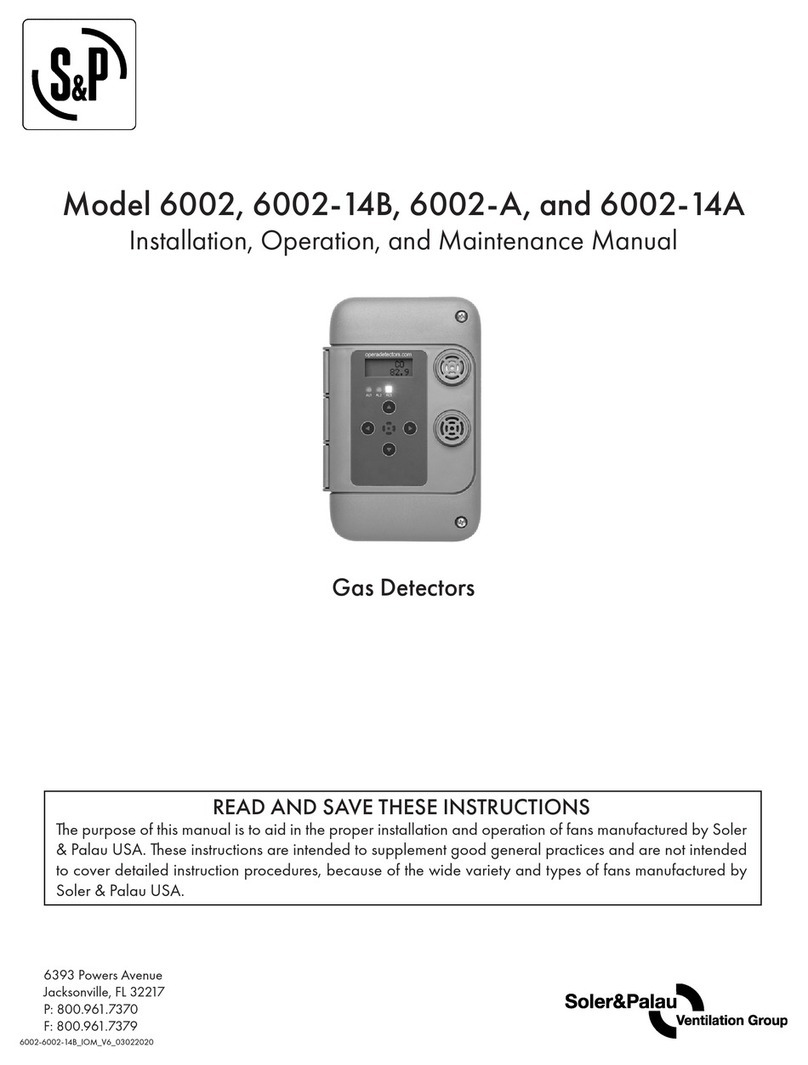
S&P
S&P 6002-A Installation, operation and maintenance manual
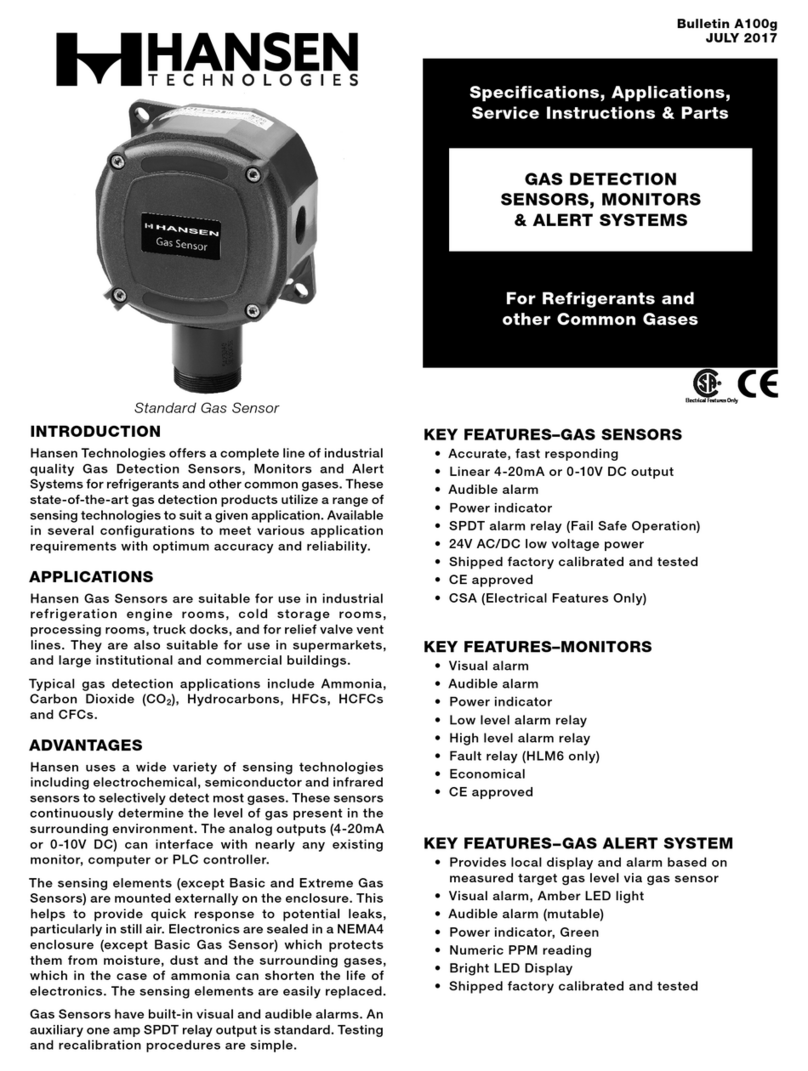
Hansen Technologies
Hansen Technologies HSC4H-N10K Specifications, Applications, Service Instructions & Parts
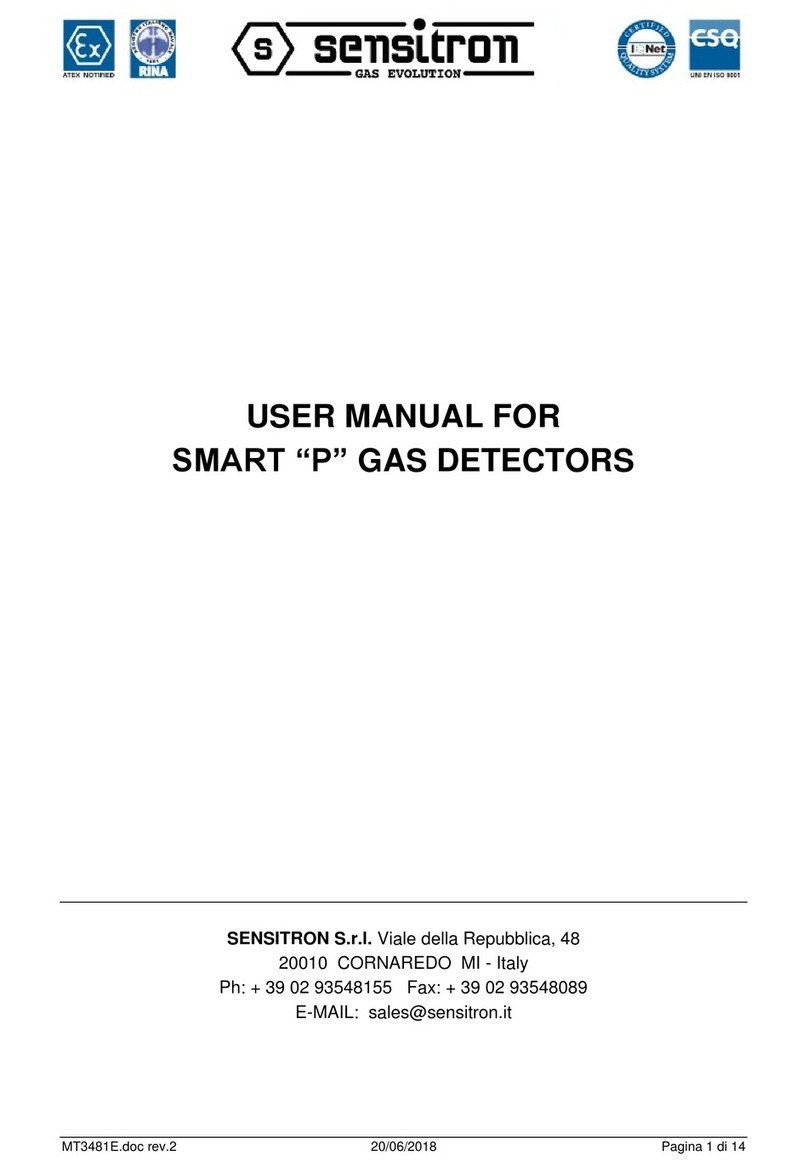
Sensitron
Sensitron P user manual
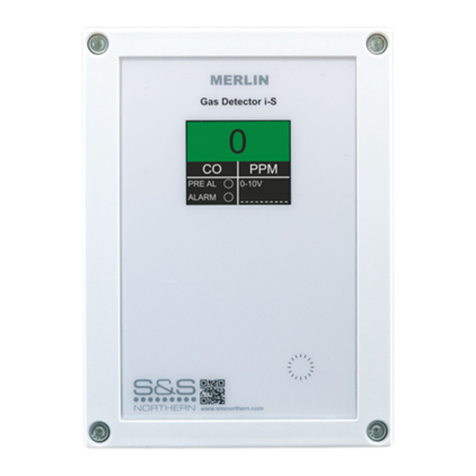
S&S Northern
S&S Northern Merlin Detector i-S Installation operation & maintenance
Inficon
Inficon IRWIN quick start guide
